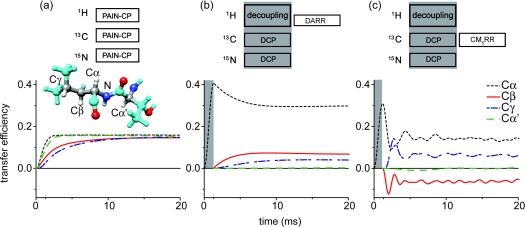Figure 10.
Backbone nitrogen to sidechain carbons polarization transfer: (a) 15N–13C δp0 PAIN-CP at ωr/2π = 20 kHz with pC = pN = 2.6 and pH = 2.4. (b) NCACX with DCP (ω1C/2π = 25 kHz, ω1N/2π = 35 kHz and 100 kHz 1H decoupling) followed by DARR (ω1H/2π = 10 kHz) mixing at ωr/2π = 10 kHz. (c) NCACX with DCP (ω1C/2π = 30 kHz, ω1N/2π = 50 kHz and 100 kHz 1H decoupling) followed by CM5RR (ω1C/2π = 100 kHz, phase ±11.46°) mixing at ωr/2π = 20 kHz. Simulations were performed at ω0H/2π = 750 MHz. The spin system [inset of panel (a)] is extracted from the Crh x-ray structure (PDB ID: 1mu4) (Ref. 30) and is composed of L63N, four aliphatic carbons L63Cα, L63Cβ, L63Cγ, T62Cα (grey atoms) and the four protons mainly involved in the spin dynamics (T62Hα, L63H, L63Hα, L63Hβ2, L63Hγ - white atoms). The chemical shifts are taken from the protein assignment (Ref. 31). L63N and the protons are irradiated on resonance. The 13C carrier frequency is set on resonance with L63Cα. The simulation includes typical CSA tensor parameter for nitrogen (−115 ppm, 0.2), aliphatic carbons (20–25 ppm, 0.0), and proton (5.7 ppm, 0.65).

